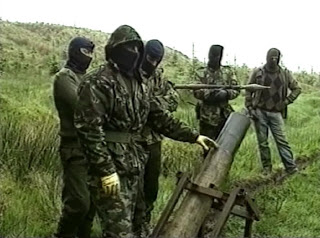Well, I have been busy with trying to find the unique stories and angles out there that no one is covering, and I think I may have found one. Who has heard of the Israeli companies Global CST or Defensive Shield? I have never heard of them, but I tell you what, they are certainly making a splash now!
For the Georgia deal, as you can see below, the work these security firms did there was significant. The Syrians are using that work as propaganda to rub it in the face of Israel as ‘another loss’. This to me is amazing, because it is a sign of how significant the roll of security companies can have on the world stage. And for the record, I tend to agree with the Israeli side, that Georgia was no match for Russia, no matter who trained them. It’s a numbers game.
And this idea of security companies getting involved with highly volatile and political situations, reminds me of the US private security company Steele Foundation and their contract to protect Aristide in Haiti several years ago. This was a prime example of a security company getting thrown into the middle of a sticky situation, while just trying to do their job.
With that deal, the State Dept. was using Steele Foundation security teams to protect Aristide, and then later run him out of Haiti towards the end of his crumbling Presidency. The funny thing about this, is that I guess Aristide had no idea that he was stepping down, according to him. And that the State Dept. blocked his request for more security guys to reinforce his current detail. Very interesting time period for the Steele Foundation guys and kudos to them for working through a complex deal like that.
But back to these Israeli Security Firms. They were also involved with the training of Colombia’s forces and rumored to have influenced the planning for Operation Jacque(hostage rescue). This was a huge deal and very complex. It looks like Global CST was involved with that one too–and was once again thrust onto the world stage in a highly public rescue. Even Ingrid Betencourte, one of the rescued hostages, commented that it was run like a ‘Israeli commando operation’.
So I guess this is an indicator that we will probably see more of these companies in the future? I know I am paying attention now. Here is a link to their website. Interesting stuff. –Head Jundi
——————————————————————-
Major General (res.) Israel Ziv, owner of Global CST.
2 Israeli firms say they left Georgia before fighting
By Amos Harel
Two Israeli security companies, Defensive Shield and Global CST, announced yesterday that they had completed their projects in Georgia before fighting between that country and Russia broke out on Friday. The two are among several Israeli companies advising Georgia on security matters, training its army and occasionally supplying it with weapons.
Defensive Shield, owned by Brig. Gen. (res.) Gal Hirsch, said all its employees, including its subcontractors, are no longer in Georgia. It said it completed the work it had been contracted to do, and that all its contracts with Georgia had been approved by Israel’s Defense Ministry. Security systems services company Global CST, managed by Maj. Gen. (res.) Israel Ziv, said it finished its work in Georgia at the end of July.
Russia expanded its bombing blitz against neighboring Georgia yesterday, targeting the country’s capital for the first time, while Georgian troops pulled out of the breakaway province of South Ossetia, as Russia demanded, the Associated Press reported.
Georgia launched a major offensive to regain control over South Ossetia overnight Friday, and some 1,500 people have reportedly been killed there since then, with the death toll rising. South Ossetia split from Georgia in the early 1990s and has since built up ties with Moscow.

